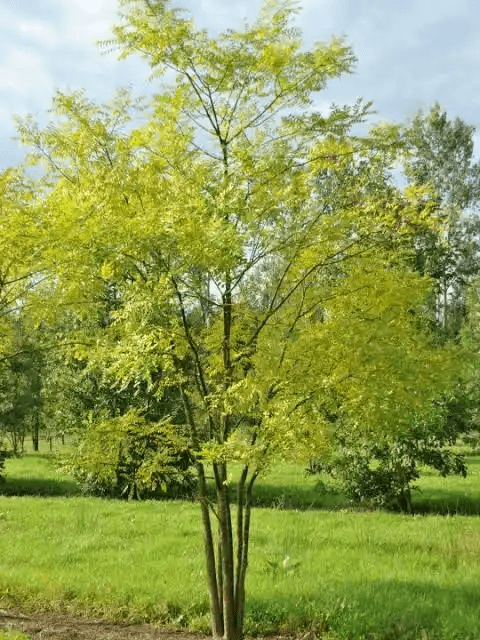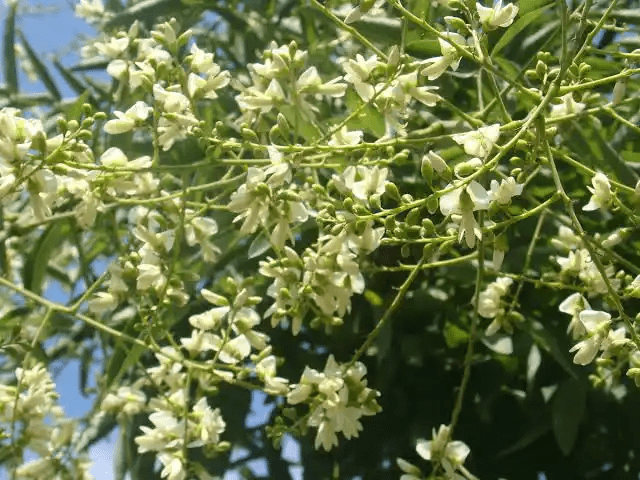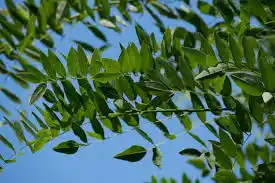Styphnolobium is a genus of flowering trees in the pea family, Fabaceae, and is commonly known as the Pagoda Tree. This genus includes several species, and among them.
Styphnolobium japonicum, also known as the Japanese Pagoda Tree, is particularly well-known and widely cultivated for its ornamental qualities.
The Japanese Pagoda Tree is a deciduous tree with a distinctive, broad-spreading crown and a straight trunk. The bark is light gray when young, becoming rough and dark brown as the tree matures.
The pinnately compound leaves are composed of smaller leaflets, creating a lush and textured foliage. During the summer, the tree produces fragrant, small, white flowers that are arranged in panicles, adding to its ornamental appeal.
One of the notable features of the Japanese Pagoda Tree is its unique fruit, which is a flat, brown pod containing seeds. The pods persist into the winter, providing visual interest even after the growing season has ended.
Beyond its aesthetic value, Styphnolobium japonicum has cultural significance. It is often planted near Buddhist temples and pagodas, hence the common name Pagoda Tree. This association with sacred sites adds to its symbolic value, representing longevity and beauty.
In landscaping and horticulture, the Pagoda Tree is valued for its adaptability to various soil types and its tolerance to pollution. These qualities make it a suitable choice for street plantings and parks in urban environments. The tree thrives in full sun and well-drained soil.
Propagation of the Japanese Pagoda Tree is typically done through seeds, although vegetative methods such as grafting and budding are also employed to maintain desirable traits in cultivated varieties. Regular pruning helps maintain its shape and remove any dead or damaged branches.
In conclusion, Styphnolobium, or the Pagoda Tree, is a genus of flowering trees appreciated for their ornamental qualities and cultural significance.
The Japanese Pagoda Tree, in particular, stands out for its distinctive appearance, fragrant flowers, and historical connections to sacred sites.
Whether gracing urban landscapes or enhancing the surroundings of religious structures, the Pagoda Tree adds to the beauty and diversity of the plant kingdom.
The Botanical Description of Styphnolobium
1. Leaf Structure: Styphnolobium, known as the pagoda tree or honey locust, features pinnately compound leaves with numerous leaflets arranged in a feather-like pattern along the central stalk.
2. Flower Characteristics: Clusters of fragrant, creamy-white flowers are a distinctive feature of the pagoda tree. These blossoms play a crucial role in the tree’s reproductive cycle, appearing abundantly during the blooming season.
3. Bark and Trunk: The bark is rough-textured and gray-brown, developing furrows and ridges as the tree matures. The trunk, sturdy and substantial, provides stability to the tree’s overall structure.
4. Foliage and Canopy: Styphnolobium’s deciduous foliage creates a dense and expansive canopy. The leaves shed in autumn, accompanied by vibrant colors ranging from yellow to golden brown.
The Geographic Distribution of Styphnolobium
1. Native Regions: Styphnolobium is native to East Asia, thriving in countries such as China, Korea, and Japan. Its adaptability is evident in its ability to flourish in various climates within these regions.
2. Cultivation in Other Regions: Due to its adaptability and aesthetic appeal, Styphnolobium has been cultivated in North America, Europe, and other temperate regions. It thrives in well-drained soils and moderate climates.
3. Preferred Habitat: The pagoda tree prefers locations with ample sunlight and well-drained soil, making it suitable for parks, gardens, and urban landscapes. Its ability to tolerate different soil conditions contributes to its widespread distribution.
The Chemical Composition of Styphnolobium
1. Phytochemicals: Styphnolobium contains a diverse array of phytochemicals, including flavonoids, saponins, and tannins. These compounds contribute to the tree’s medicinal and therapeutic properties, making it of interest in traditional medicine practices.
2. Flavonoid Content: Notably, Styphnolobium has a high flavonoid content, including quercetin and kaempferol. These flavonoids exhibit antioxidant properties that can positively impact human health.
3. Medicinal Applications: Traditional medicine systems in native regions utilize various parts of the tree for medicinal purposes. Extracts from the bark, leaves, and flowers are explored for potential anti-inflammatory, antiviral, and antioxidant properties.
4. Potential Uses in Modern Medicine: Ongoing research into Styphnolobium’s chemical composition explores potential applications in modern medicine. Bioactive compounds within the tree open avenues for pharmaceutical and therapeutic developments.
Read Also: Guide to Slaughter and Conversion of Muscle to Meat
The Medicinal Health Benefits Of Styphnolobium (Pagoda Tree)

1. Anti-Inflammatory Properties: Styphnolobium exhibits potent anti-inflammatory effects, making it beneficial for conditions involving inflammation, such as arthritis and joint pain.
2. Antioxidant Boost: The tree’s high flavonoid content provides a significant antioxidant boost, aiding in the neutralization of free radicals and supporting overall health.
3. Immune System Support: Compounds found in Styphnolobium may contribute to immune system enhancement, potentially helping the body defend against infections and illnesses.
4. Respiratory Health: Styphnolobium has been traditionally used to promote respiratory health, with potential benefits for conditions like asthma and bronchitis.
5. Cardiovascular Support: The medicinal properties of Styphnolobium may positively impact cardiovascular health by promoting healthy blood circulation and reducing the risk of certain heart-related issues.
6. Liver Function: Studies suggest that Styphnolobium may support liver function, aiding in detoxification processes and promoting overall liver health.
7. Antiviral Effects: Some compounds in Styphnolobium may exhibit antiviral properties, contributing to the prevention and management of viral infections.
8. Relaxation and Stress Relief: The tree’s extracts are believed to have calming effects, potentially aiding in stress relief and promoting relaxation.
9. Digestive Health: Styphnolobium may have benefits for the digestive system, with potential effects on conditions like indigestion and bloating.
10. Anticancer Potential: Ongoing research explores the potential anticancer properties of Styphnolobium, with a focus on inhibiting the growth of certain cancer cells.
11. Bone Health: Compounds in Styphnolobium may contribute to bone health, potentially reducing the risk of osteoporosis and supporting overall bone density.
12. Anti-Anxiety Effects: Some traditional uses suggest that Styphnolobium may have anti-anxiety effects, contributing to mental well-being.
13. Wound Healing: External applications of Styphnolobium extracts may promote wound healing and skin regeneration.
14. Anti-Aging Properties: The antioxidant-rich nature of Styphnolobium may contribute to anti-aging effects by protecting the skin from oxidative stress.
15. Blood Sugar Regulation: Preliminary studies indicate potential benefits in regulating blood sugar levels, making Styphnolobium of interest for diabetes management.
16. Anti-allergic Effects: Styphnolobium may have anti-allergic properties, offering relief from allergic reactions and related symptoms.
The Methods of Usage to Achieve the Provided Health Benefits Of Styphnolobium (Pagoda Tree)
1. Herbal Infusions: Prepare herbal teas by infusing Styphnolobium leaves or flowers in hot water to enjoy the anti-inflammatory and antioxidant benefits.
2. Tinctures and Extracts: Tinctures and extracts are convenient ways to harness the medicinal properties of Styphnolobium. These can be added to beverages or taken in controlled doses.
3. Dietary Supplements: Capsules or tablets containing Styphnolobium extracts are available as dietary supplements, providing a concentrated form for easy consumption.
4. Topical Applications: Create balms or creams with Styphnolobium extracts for topical application, promoting wound healing, and addressing skin conditions.
5. Culinary Use: Some cultures incorporate Styphnolobium flowers into culinary dishes, providing a flavorful twist while potentially offering health benefits.
6. Aromatherapy: Essential oils derived from Styphnolobium may be used in aromatherapy, contributing to relaxation and stress relief.
7. Inhalation Therapy: Inhaling the steam from a Styphnolobium-infused solution may benefit respiratory health and provide relief from congestion.
The Side Effects Of Using Styphnolobium Medicinal Plant
1. Allergic Reactions: Some individuals may experience allergic reactions to Styphnolobium, presenting as skin rashes, itching, or respiratory discomfort.
2. Gastrointestinal Distress: Excessive consumption may lead to gastrointestinal issues such as nausea, vomiting, or diarrhea.
3. Drug Interactions: Styphnolobium may interact with certain medications, so individuals on prescription drugs should consult with a healthcare professional before use.
4. Pregnancy and Lactation: Pregnant and lactating women should exercise caution, as the safety of Styphnolobium during these periods is not well-established.
5. Central Nervous System Effects: High doses may cause drowsiness or sedation, affecting concentration and alertness.
6. Blood Pressure Regulation: Individuals with blood pressure concerns should monitor their intake of Styphnolobium, as it may influence blood pressure levels.
7. Photosensitivity: Some individuals may experience increased sensitivity to sunlight, so precautions such as sunscreen use are advised.
8. Liver Function: While Styphnolobium is generally believed to support liver health, excessive use may have unintended effects on liver function in some individuals.
Read Also: 20 Medicinal Health Benefits Of Bambusa vulgaris (Bamboo)
The Scientific Research and Studies of Styphnolobium

1. Anti-Inflammatory Properties: Numerous scientific studies have explored the anti-inflammatory properties of Styphnolobium, investigating its potential applications in conditions such as arthritis and inflammatory disorders.
2. Antioxidant Effects: Scientific research indicates that the high flavonoid content in Styphnolobium contributes to its antioxidant effects, helping combat oxidative stress and associated health issues.
3. Immunomodulatory Potential: Studies suggest that compounds found in Styphnolobium may modulate immune system responses, highlighting its potential in supporting overall immune health.
4. Respiratory Health Benefits: Ongoing scientific investigations focus on the potential benefits of Styphnolobium for respiratory health, with implications for conditions like asthma and bronchitis.
5. Cardiovascular Impact: Scientific research has delved into the cardiovascular effects of Styphnolobium, examining its role in promoting healthy blood circulation and reducing cardiovascular risks.
6. Hepatoprotective Properties: Studies explore the hepatoprotective properties of Styphnolobium, indicating its potential in supporting liver function and detoxification processes.
7. Antiviral Activity: Research has investigated the antiviral effects of Styphnolobium, exploring its role in preventing and managing viral infections.
8. Neuroprotective Effects: Preliminary studies suggest that Styphnolobium may have neuroprotective effects, with potential implications for cognitive health.
9. Gastrointestinal Benefits: Scientific exploration into Styphnolobium includes its impact on digestive health, with potential benefits for conditions like indigestion and bloating.
10. Anticancer Properties: Ongoing research investigates the potential anticancer properties of Styphnolobium, focusing on its ability to inhibit the growth of certain cancer cells.
The Safety Precautions and Recommendations In Using Styphnolobium Medicinal Plant
1. Allergies: Individuals with known allergies should exercise caution when using Styphnolobium and monitor for any allergic reactions, such as skin rashes or respiratory discomfort.
2. Dosage Control: Adhering to recommended dosage guidelines is crucial to avoid potential side effects. Excessive consumption may lead to gastrointestinal distress or other complications.
3. Consultation with Healthcare Professionals: Before incorporating Styphnolobium into a healthcare routine, it’s advisable to consult with healthcare professionals, especially for individuals with existing medical conditions or those taking prescription medications.
4. Pregnancy and Lactation: Pregnant and lactating women should exercise caution and seek medical advice before using Styphnolobium, as its safety during these periods is not well-established.
5. Monitor Blood Pressure: Individuals with blood pressure concerns should monitor their blood pressure regularly when using Styphnolobium, as it may influence blood pressure levels.
6. Potential Photosensitivity: Some individuals may experience increased sensitivity to sunlight, so precautions like sunscreen use are recommended during Styphnolobium use.
FAQs About Styphnolobium Medicinal Plant
1. Is Styphnolobium safe for daily use?
Yes, when used within recommended dosage guidelines, Styphnolobium is generally safe for daily use. However, it’s essential to consult with a healthcare professional before starting any new herbal regimen.
2. Can Styphnolobium be used during pregnancy?
Pregnant women should exercise caution and consult with a healthcare provider before using Styphnolobium, as its safety during pregnancy is not well-established.
3. Are there any known drug interactions with Styphnolobium?
Individuals on prescription medications should consult with a healthcare professional to ensure there are no potential interactions between Styphnolobium and their medications.
4. Can Styphnolobium be used for children?
The use of Styphnolobium for children should be done under the guidance of a healthcare professional, as dosage and safety considerations may vary.
5. Are there specific conditions where Styphnolobium should be avoided?
Individuals with allergies to Styphnolobium or its related species should avoid its use. Additionally, those with specific medical conditions should seek professional advice before incorporating it into their health regimen.
6. How long does it take to experience the health benefits of Styphnolobium?
The time it takes to experience the health benefits of Styphnolobium can vary among individuals. Factors such as dosage, frequency, and individual response contribute to the timeframe. It’s advisable to be consistent with usage and monitor changes over several weeks.
7. Can Styphnolobium be used in combination with other herbal supplements?
While Styphnolobium is generally safe, it’s crucial to exercise caution when combining it with other herbal supplements. Some combinations may have unknown interactions, so consulting with a healthcare professional is recommended.
8. Are there specific contraindications for Styphnolobium use?
Individuals with certain medical conditions, such as liver disorders or autoimmune diseases, should consult with a healthcare provider before using Styphnolobium, as it may have contraindications in these cases.
9. Can Styphnolobium be consumed on an empty stomach?
While Styphnolobium is generally well-tolerated, some individuals may experience mild gastrointestinal discomfort when taken on an empty stomach. It’s advisable to take it with food or as directed by a healthcare professional.
10. Are there any age restrictions for using Styphnolobium?
While there is no strict age restriction, the dosage and form of Styphnolobium may need adjustment for different age groups. It’s recommended to consult with a healthcare professional, especially for children and the elderly.

